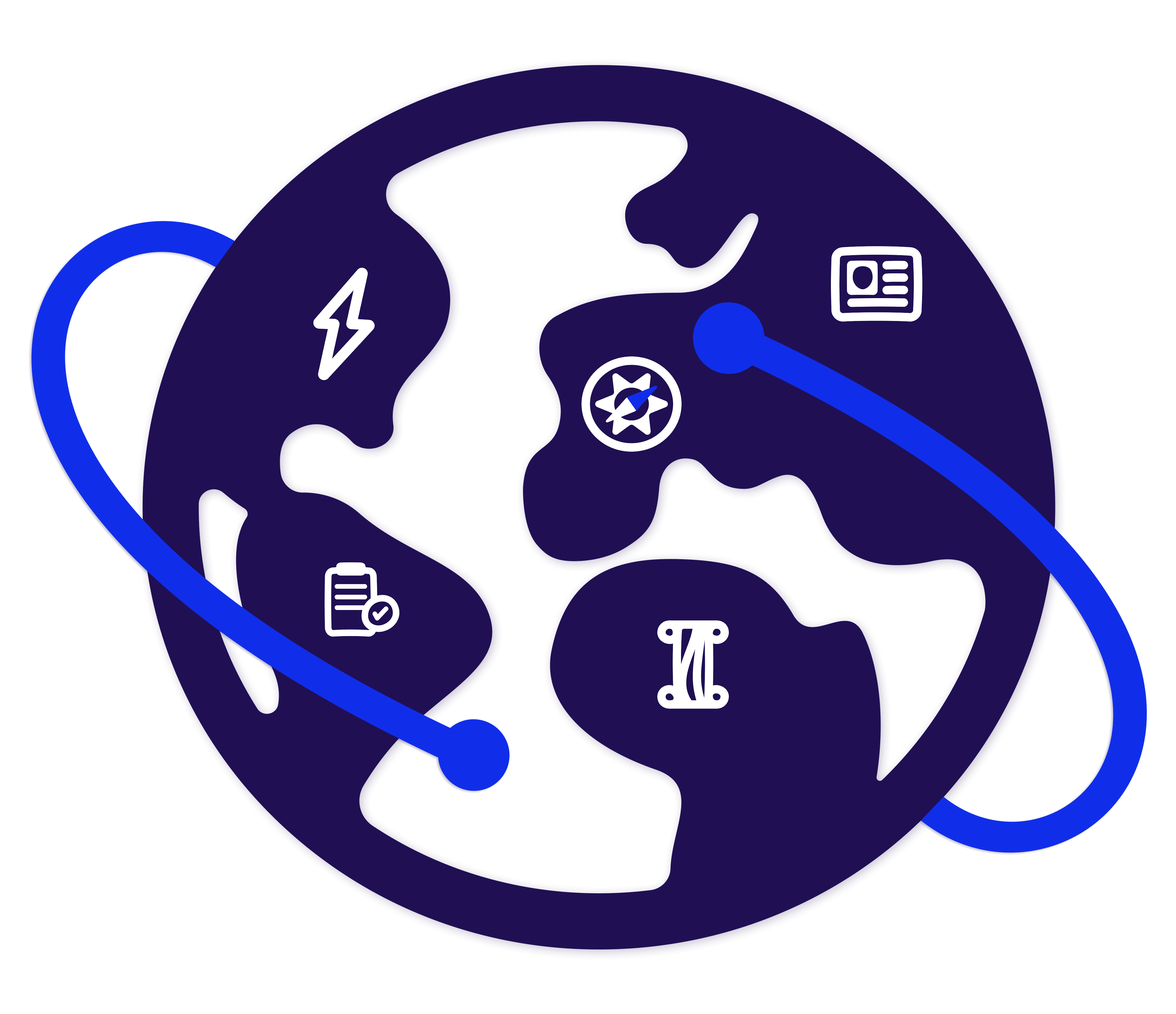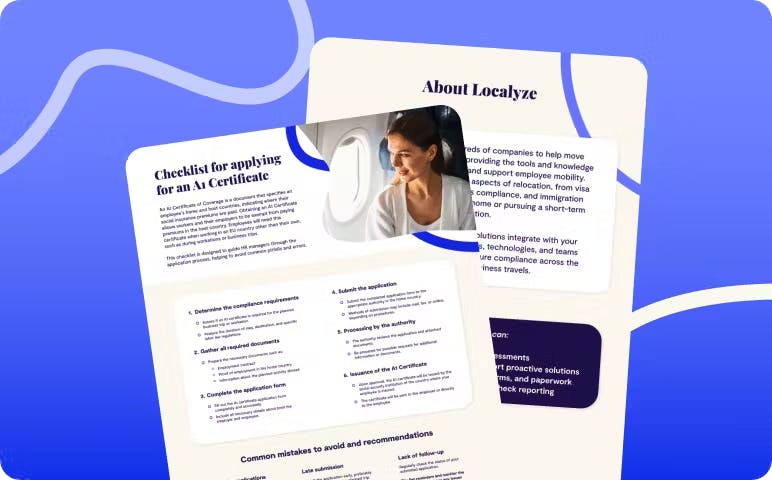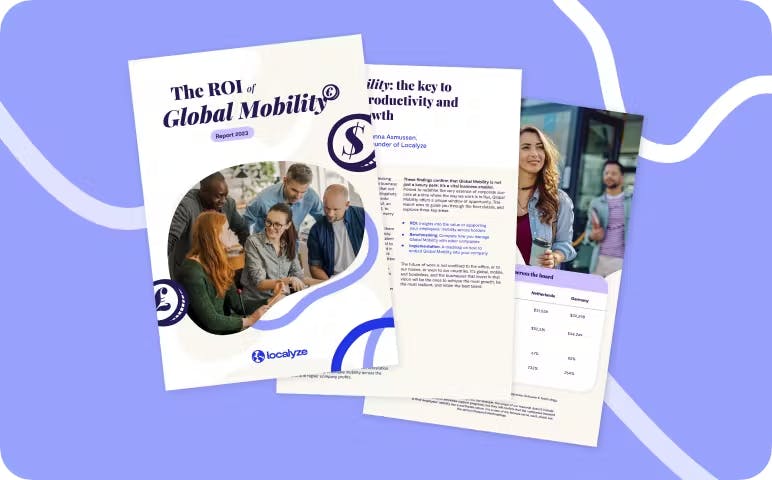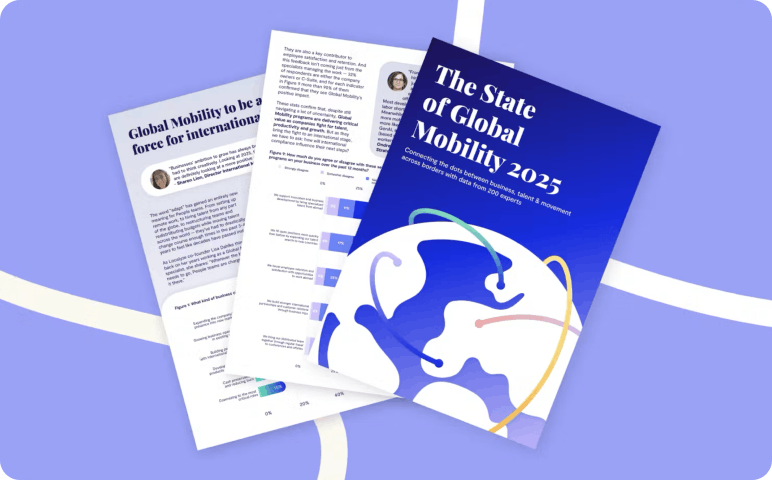Scaling Global Talent Mobility: Strategies for Global Enterprises
This report aims to equip enterprise Global Mobility professionals with actionable strategies to scale talent mobility efforts effectively, while mitigating risks. Our insights are drawn from survey data gathered in January 2025, best practices gleaned from interviews with enterprise Global Mobility leaders, and our own real-world experiences delivering Global Mobility services to global organizations. The survey encompassed 100 participants and qualitative interviews with global mobility professionals.

Introduction
Global Mobility is at a pivotal juncture, shaped by several converging factors that are particularly pronounced for enterprise organizations operating across multiple jurisdictions:
Geopolitical dynamics
The current geopolitical landscape has increased the complexity of talent mobility, as stricter immigration policies and evolving regulations create new challenges for organizations. Enterprise companies, with their vast international footprints, must navigate an increasingly fragmented regulatory environment while managing workforce stability across regions.
Evolving employee expectations
Employees' desire for flexibility and novel work arrangements continues to grow, and enterprise organizations must balance these expectations with the realities of compliance, tax obligations, and workforce planning on a global scale.
More diverse cases
As fluidity across borders has grown, Global Mobility teams have had to deal with a wider range of cases that add complexity to their work. Often, those diverse case types also result in more tools and providers being involved, bringing their own management challenges.
Technological advancements
The rapid evolution of technology, particularly artificial intelligence, compels Global Mobility professionals to innovate to address operational and cost-related pressures. Enterprises, due to their scale, must integrate these technologies efficiently to maintain consistency across diverse markets.

At the same time, the challenges that have long defined Global Mobility—global compliance, risk management, and the ability to scale effectively—remain. However, for enterprise organizations, these challenges are magnified. Managing cross-border compliance for thousands of employees, aligning mobility strategies with regional business needs, and ensuring operational efficiency at scale all introduce layers of complexity that smaller organizations do not face.
In this report, we will explore:
- The challenges of implementing Global Mobility at an enterprise scale
- Strategies for mitigating global compliance and risk
- Approaches to scaling and customizing Global Mobility operations to align with organizational needs
- Methods for defining ROI and understanding the impact of KPIs on Global Mobility initiatives
- Future predictions for Global Mobility, featuring insights from various experts in the field
Chapter 1:
The Challenges of Enterprise-Scale Global Mobility Programs
Enterprise global mobility programs face a unique set of challenges due to their sheer scale and complexity. With operations spanning multiple jurisdictions and large, distributed teams, these programs must balance compliance, operational efficiency, and employee experience while navigating an ever-changing regulatory environment.
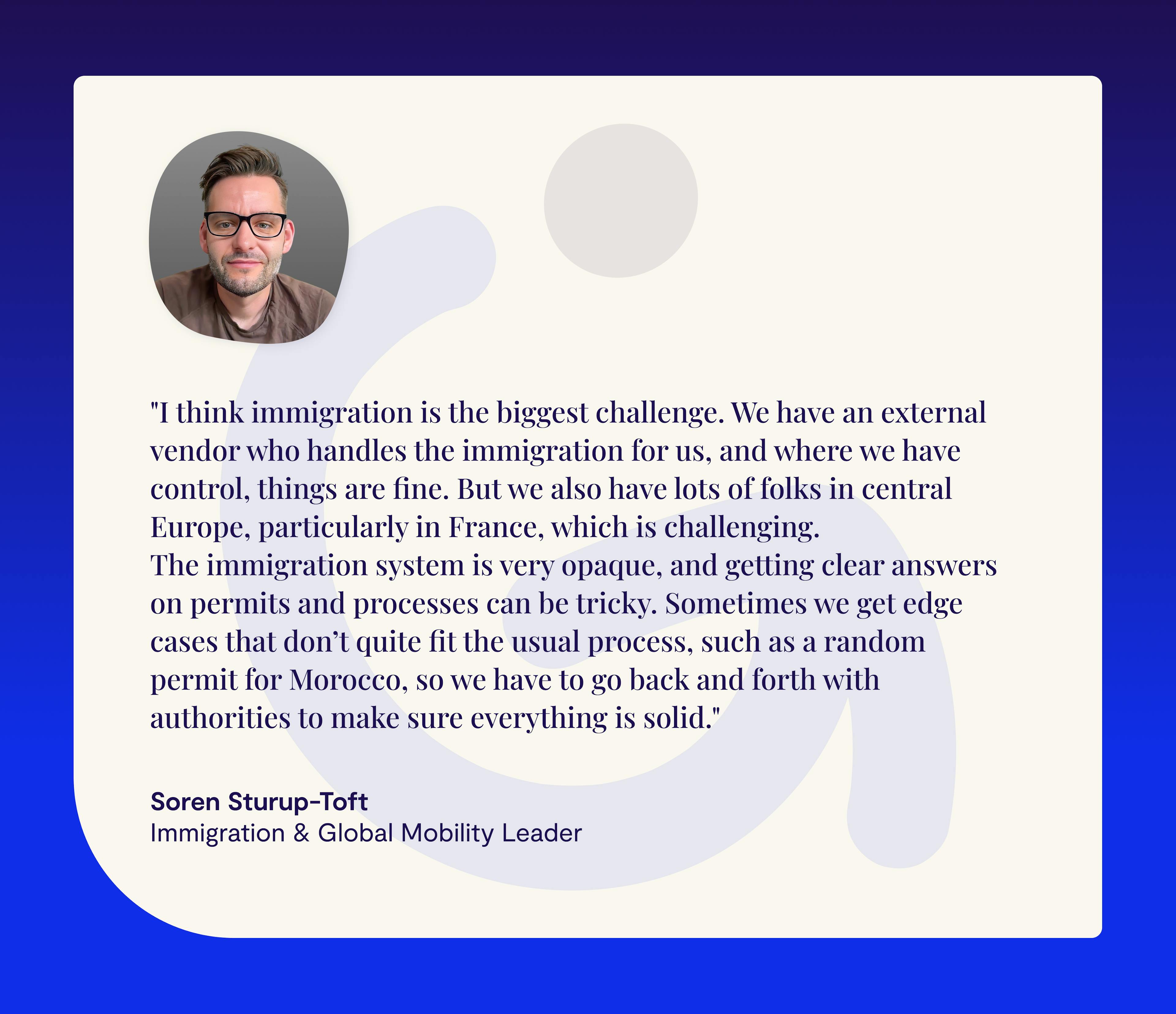
Key challenges facing enterprise Global Mobility programs:
- Managing large, distributed teams - More people in more locations means increased complexity. Ensuring smooth operations, compliance, and effective workforce planning requires well-structured policies and robust technology solutions.
- Navigating compliance in multiple jurisdictions - Unlike smaller organizations, enterprises must adhere to immigration, tax, and employment laws across numerous countries. Coupled with the rate of change of legislation in some jurisdictions, it's far more challenging for enterprises to ensure they stay compliant, introducing additional risk, and the consequences of litigation, fines, or reputational damage.
Challenges Highlighted by Our Industry Experts
Our interviews with Global Mobility leaders at top enterprises revealed some of the most pressing concerns facing mobility teams:

Globally Distributed Teams
Małgorzata Miaśkiewicz, Delivery Hero
"Right now, each brand within our company operates independently, but we're working towards greater alignment. The goal is to have consistent policies and vendors across the board, but getting buy-in across different entities takes time."

Compliance in Multiple Jurisdictions
Olumide Euba, WPP
"One significant challenge is navigating varying immigration requirements across regions. While some countries may process visas within a few weeks, others can take up to six months. Setting clear expectations with business leaders is crucial to managing these timelines effectively."

Educating the Wider Business
Sally Flaxman, Remote
"Stricter immigration laws require clear boundaries. At Remote, we always prioritise compliance, but ensuring that clients and employees understand and follow immigration, cross-border movement, and tax policies can be challenging. That’s why education is key—helping everyone understand the risks and responsibilities involved is essential to staying compliant."

Visas and work permits
Vaida Baltušninkė, Vinted
"The biggest risk is missing work permit or visa renewal deadlines. We need to track expiration dates closely and ensure employees renew their permits on time. There were cases where we were within days of an employee's permit expiring, and that's a stressful situation. Everything worked out, but it was a close call."

Insights from the 2025 Survey
The data suggests that immigration challenges have become significantly more pressing for enterprise Global Mobility leaders in 2025 compared to 2023. This shift likely reflects the impact of stricter immigration policies worldwide, making it harder for organizations to move talent efficiently across borders. Interestingly, fewer respondents now cite compliance with local laws and managing cultural differences as key concerns. This could indicate that enterprises have become more adept at navigating these aspects of global mobility, possibly due to improved internal processes, stronger vendor relationships, or increased investment in compliance frameworks.
Summing It Up
As enterprises scale their Global Mobility programs, they must contend with increased complexity, greater risk exposure, and higher operational burdens. Unlike smaller organizations, enterprises also face greater reputational risks—any misstep in compliance or employee mobility can attract public scrutiny, potentially impacting brand reputation, customer trust, and shareholder confidence.

Spotlight: The Rise of Hybrid Global Mobility Management
Many enterprises have differing approaches to insourcing vs. outsourcing in their Global Mobility programs. Some prefer to keep mobility functions in-house to maintain control and quality, while others outsource key processes to reduce internal burdens and operational costs.

Survey data shows that more organizations are choosing to manage mobility in-house compared to 2023, likely in an effort to ensure a higher quality of service. Interestingly, while fewer organizations rely solely on external tools for immigration and relocation—only 7% and 5% respectively—there is a notable increase in the number of enterprises adopting a hybrid approach, integrating software alongside insourced and outsourced solutions.
This suggests that rather than moving away from technology altogether, enterprises are looking for ways to blend multiple approaches to optimize efficiency and service quality.
Challenges of insourcing mobility functions
While insourcing offers greater control, it also introduces new obstacles:
- Fragmented technology ecosystems – A mix of tools with overlapping functionalities and lack of integration can make enterprise-wide mobility management difficult.
- Expertise management – Keeping pace with changing immigration laws and compliance requirements demands ongoing investment in specialized knowledge.
- Increased administrative burden – Global Mobility leaders must now manage employees rather than just overseeing vendors, adding a layer of complexity.
- Higher costs – While insourcing often leads to better service quality, it can increase operational costs compared to outsourcing.
Challenges of outsourcing mobility functions
Outsourcing can alleviate some of these challenges, but comes with its own risks:
- Quality control – Service levels may suffer if external partners don't meet expectations.
- Vendor dependency – Over-reliance on external providers can create gaps in institutional knowledge.
- Limited customization – Vendors may not always align with an enterprise's specific needs, leading to inefficiencies.
- Data security – External parties will be handling personal information about your employees. If their security isn't tight, you may be the victim of data leaks through your vendor network, opening you up to increased risk of litigation and reputational damage.
Insource or Outsource?
Ultimately, the decision to insource or outsource mobility functions depends on an organization's scale, budget, and strategic priorities. But as our survey shows, enterprises are increasingly opting for a hybrid approach, blending internal expertise with external support to optimize efficiency and compliance.
Chapter 2:
Mitigating Global Compliance and Risk
Compliance failures in immigration and tax regulations can lead to severe consequences for enterprise organizations. These include:
💶 Fines that could be incurred due to non-compliance.
⏰ Delayed start dates for employees, potentially resulting in productivity losses.
🏢 Reputational damage that could impact the company's standing as both an employer and a business.
❌ A negative employee experience, which may lead to increased attrition.
Given the stakes, mitigating risk is a critical priority for global mobility teams.
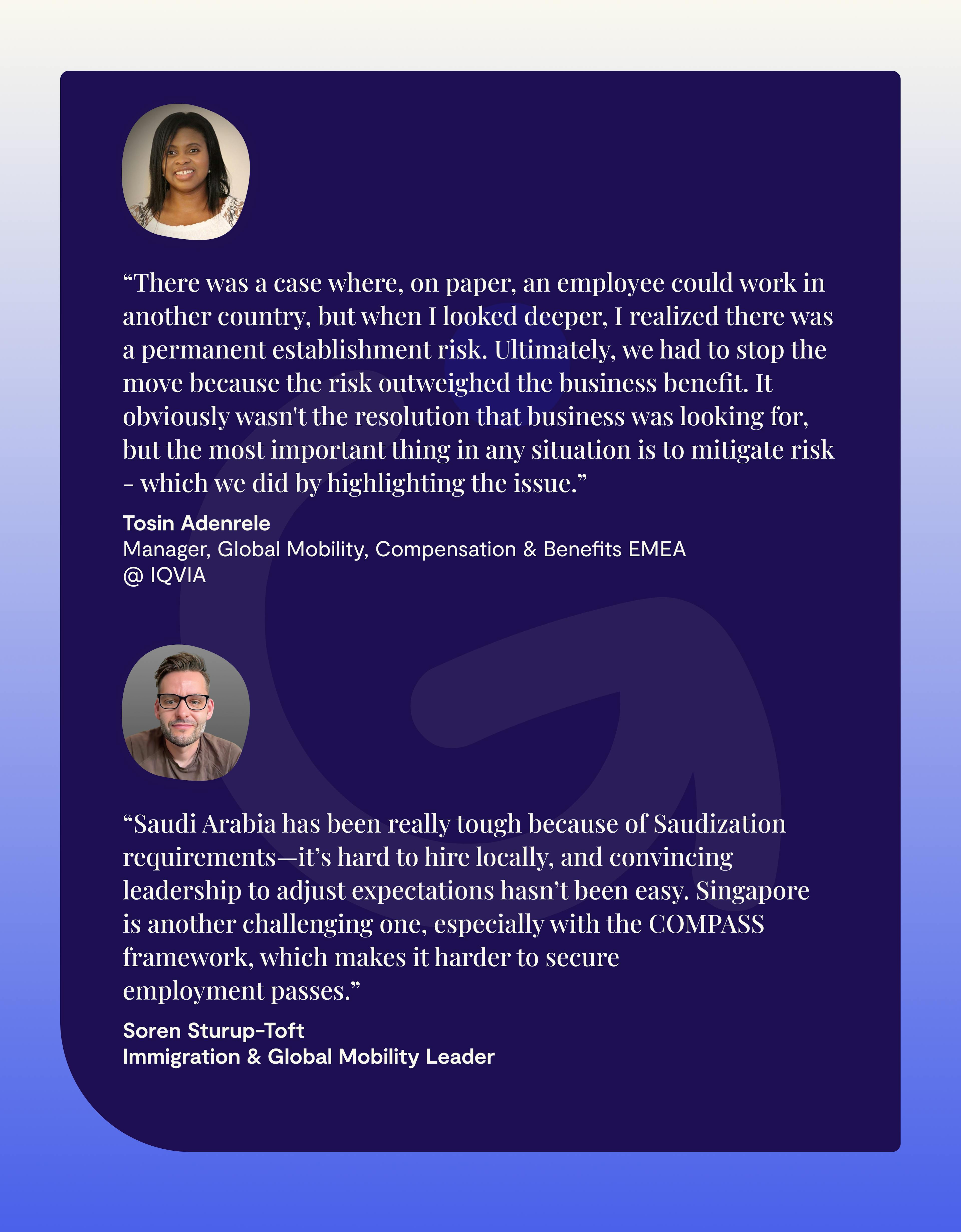
Why is compliance so difficult to manage?
Managing compliance at scale is inherently complex due to the ever-changing nature of global regulations. According to KPMG, compliance and risk insights are the second most important priority for global mobility professionals, just behind program cost considerations.
Several key factors contribute to this challenge:
- Complexity across multiple jurisdictions – Understanding compliance requirements in various countries takes time and expertise. Many enterprises opt to outsource compliance-related work for particularly complex jurisdictions.
- Political shifts are adding new uncertainty – The 2025 European elections and the new U.S. presidency are already driving regulatory changes. This means that even well-established compliance processes may soon become outdated, adding further volatility to mobility programs.
How organizations are mitigating compliance risks
Despite these challenges, many global mobility teams are adopting proactive strategies to mitigate risk:
- Leveraging third-party expertise – Some enterprises delegate complex compliance cases to external partners, reducing their liability while ensuring adherence to local laws.
- Educating internal stakeholders – Many global mobility leaders are working to train HR and business teams on country-specific compliance requirements, including visa processing times and workation restrictions, to prevent last-minute issues.
- Investing in technology – Compliance tracking software helps teams manage renewals, flag risks, and centralize compliance processes, ensuring nothing falls through the cracks.
By taking a structured and proactive approach to compliance, enterprises can reduce risk exposure, maintain operational efficiency, and provide a seamless mobility experience for employees.

Chapter 3:
Scaling and Customizing Your Operations
Global mobility efforts vary widely across organizations. Some are strategic departments, consulted ahead of key decisions and integrated into broader business strategy. Others operate as reactive, tactical functions, responding to mobility requests as they arise.
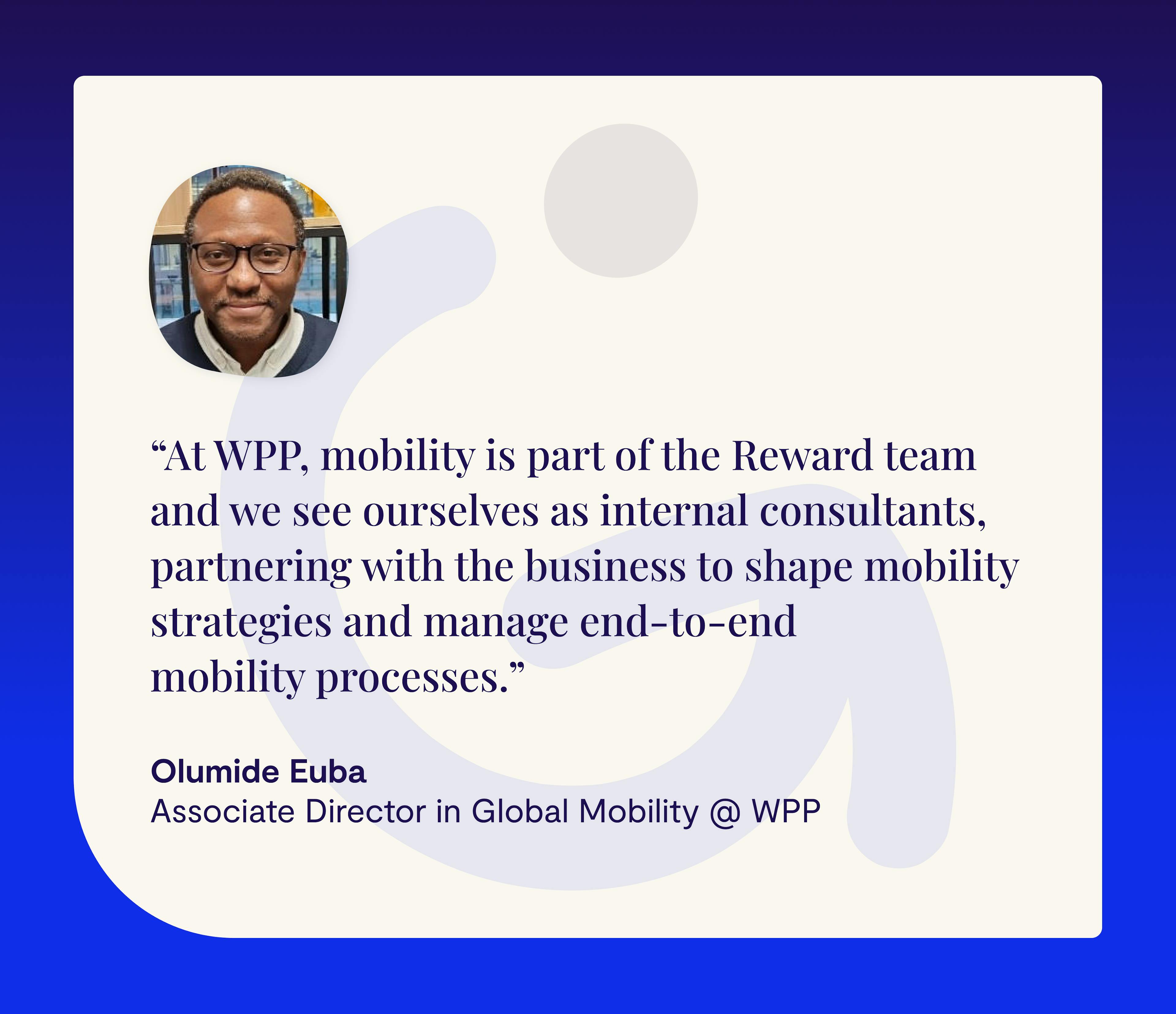
Our survey data suggests that 96% of respondents have a dedicated global mobility team, a figure that has remained consistent since 2023. However, there has been a notable shift in team distribution. In 2025, 76% of teams operate across multiple locations, up from 64% in 2023. This suggests a growing emphasis on local expertise and in-house knowledge to better navigate compliance and logistical challenges.
Regardless of where an organization sits on the maturity scale, the goal is often the same: to evolve global mobility efforts to better support business needs, address market shifts, and improve operational efficiency. This chapter explores two key areas enterprises are focusing on to scale effectively: managing diverse case types and leveraging technology.
Managing Diverse Case Types
Enterprise global mobility teams handle a broad range of mobility scenarios, from short-term assignments to permanent relocations, each with unique challenges. Managing these diverse cases requires balancing insourcing vs. outsourcing strategies.
Outsourcing: when and why?
Organizations often outsource mobility functions to access specialist expertise, ensure compliance, and streamline costs. According to KPMG research, outsourcing is particularly common for:
- Immigration and work permit processing
- Tax and legal compliance
- Relocation and employee onboarding
Admin tasks related to immigration, work permit processing and employee visas (36%) and Compliance knowledge related to local laws and regulations (28%) are the most frequently outsourced parts of the services.
Many enterprises rely on vendors such as Localyze to manage complex compliance cases and ensure smooth employee transitions.
Outsourcing can also be a deliberate strategic choice, rather than just filling capability gaps. The enterprise Global Mobility and Immigration Leader we spoke to, for instance, outsources operational tasks to focus internal resources on high-value strategic work.
Survey data from 2025 and 2023 reveals shifting trends in outsourcing. More enterprises are managing mobility in-house, particularly for relocation services, but there is also a marked increase in organizations using a hybrid approach, blending internal teams with external support.
The case for insourcing
While outsourcing provides access to expertise and cost efficiencies, insourcing offers greater control and customization. Many enterprises favor insourcing for:
- Maintaining direct oversight over global mobility strategy
- Tailoring mobility policies to fit business needs and employee experience
- Ensuring seamless integration with other HR and operational processes
A growing number of organizations are adopting a hybrid model, using technology partners to handle administrative burdens while keeping strategic decision-making in-house. This allows them to balance cost control, quality, and agility.
How Enterprises Manage Different Case Types
Organizations take different approaches to handling mobility cases based on their priorities and resources:
🌎 Outsourcing as much as possible, keeping only strategic oversight in-house
🌎 Use external providers as an overflow resource when internal teams are maxed out
🌎 Blend in-house support for routine admin with specialist vendors for complex cases
🌎 Handle simple cases in-house while outsourcing technical compliance needs
Hear from the experts themselves:

Outsource as much as possible, keeping only strategic oversight in-house
Soren Sturup-Toft, Immigration & Global Mobility Leader
"We run on a lean model, so we outsource as much as possible while keeping strategic oversight. Anything operational—document collection, visa applications, apostilling—that's all vendor work. But when it comes to risk management and compliance strategy, that stays in-house."

Use external providers as an overflow resource when internal teams are maxed out
Malgorzata Miaśkiewicz, Delivery Hero
"If we don't have the expertise or capacity in-house, outsourcing is the way to go. [We outsource] anything that requires deep local expertise, like immigration and tax filings."

Blend in-house support for routine admin with specialist vendors for complex cases
Vaida Baltušninkė, Vinted
"We help employees with questions, assist with permits if needed, and coordinate with third-party providers like Localyze. We don’t have internal global mobility experts, so external partners play a key role in making sure everything runs smoothly."
The role of technology
Survey data indicates a decline in the number of enterprises relying solely on external technology tools for mobility management. Whether that is due to increased outsourcing, or due to a shift towards hybrid models where technology is integrated alongside internal and external teams, the role of technology in global mobility is worth exploring.
Any enterprise-level professional will be aware of the never-ending pressure to control costs – even in 2025, according to Boston Consulting Group, cost control is the primary strategic driver in enterprise operations. Technology tools represent an obvious opportunity to reduce administrative burden on global mobility professionals, enabling Global Mobility teams to manage with reduced headcount. Given that outsourcing is also a way Globally Mobility teams control costs, it seems likely that the reduction in teams relying solely on technology (ie managing everything in-house) and the rise in hybrid approaches represents Global Mobility teams attempting to get the best of both worlds.
According to Deloitte research, the most widely used technology solutions in global mobility include:
- Vendor systems for immigration, tax, and relocation.
- HRIS platforms integrated with broader HR functions.
Most enterprises take a decentralized approach, using a combination of specialized tools. This method has pros and cons:
Advantages
- Leverages deep expertise from best-in-class providers
- Builds redundancy, reducing risk if a tool fails or a vendor reaches capacity
Disadvantages
- Application sprawl increases inefficiency and training burdens
- Compliance risks arise if tools aren’t maintained or updated
- High subscription costs make decentralized tech stacks expensive
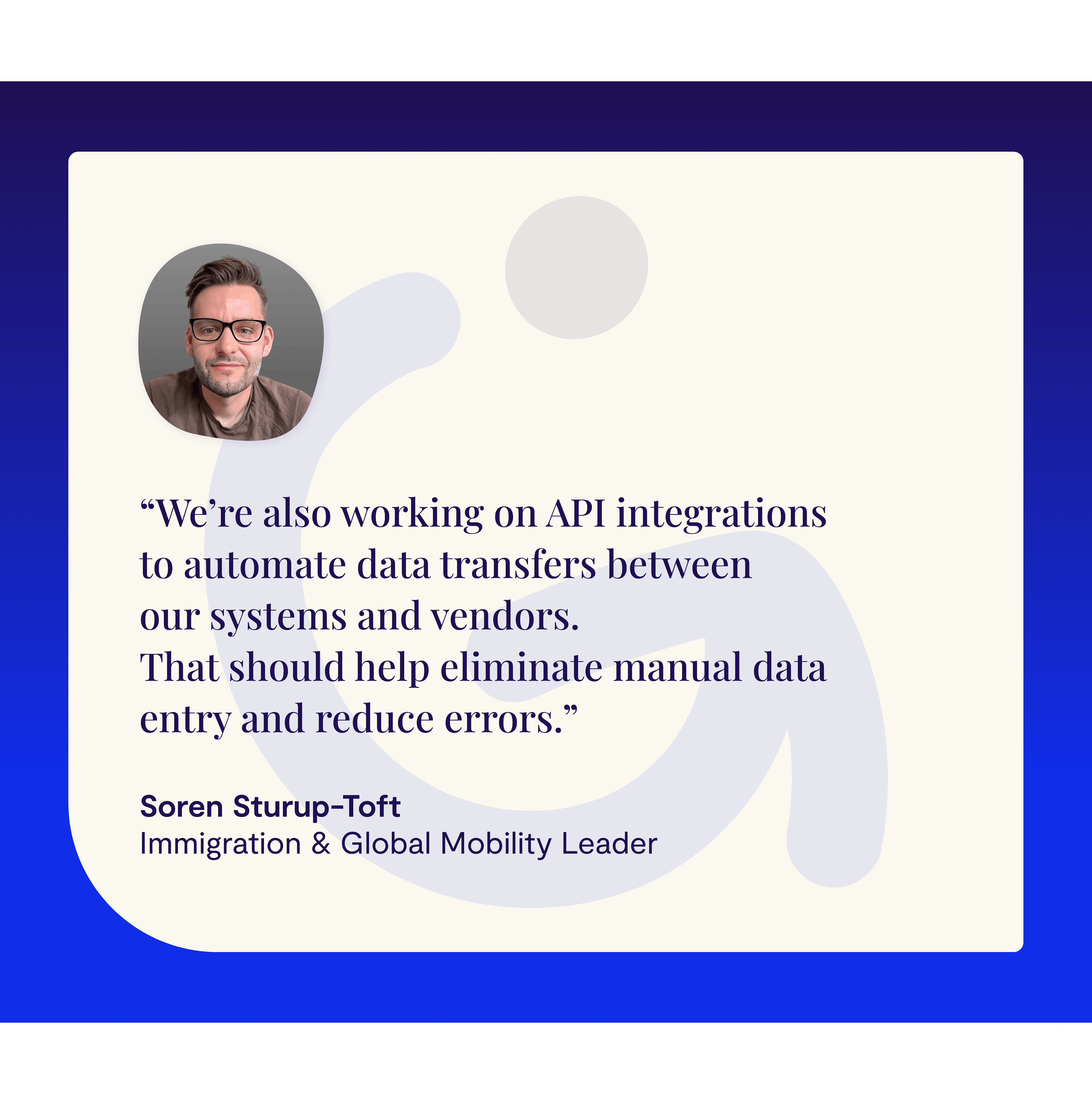
The Shift Toward Centralization
Many enterprises are consolidating their technology stacks to improve efficiency:
- 33% of global mobility professionals plan to optimize or upgrade their technology in the next two years (Deloitte)
- 37% are prioritizing technology-enabled global mobility programs as a strategic goal (Deloitte)
A fully centralized approach simplifies management but risks losing specialized functionality. Some organizations opt for integrated technology ecosystems, linking multiple tools via APIs to maintain functionality while reducing complexity.
Data Integrity and AI
Additionally, 66% of organizations aim to leverage generative AI for efficiency, while 42% hope to reduce administrative workloads (Deloitte).
High-quality data is critical for any global mobility system. Even the best tools cannot compensate for inaccurate or incomplete data.
If you're planning to use AI-powered tools in your global mobility efforts, it's vital to make sure your data is of a high enough quality.
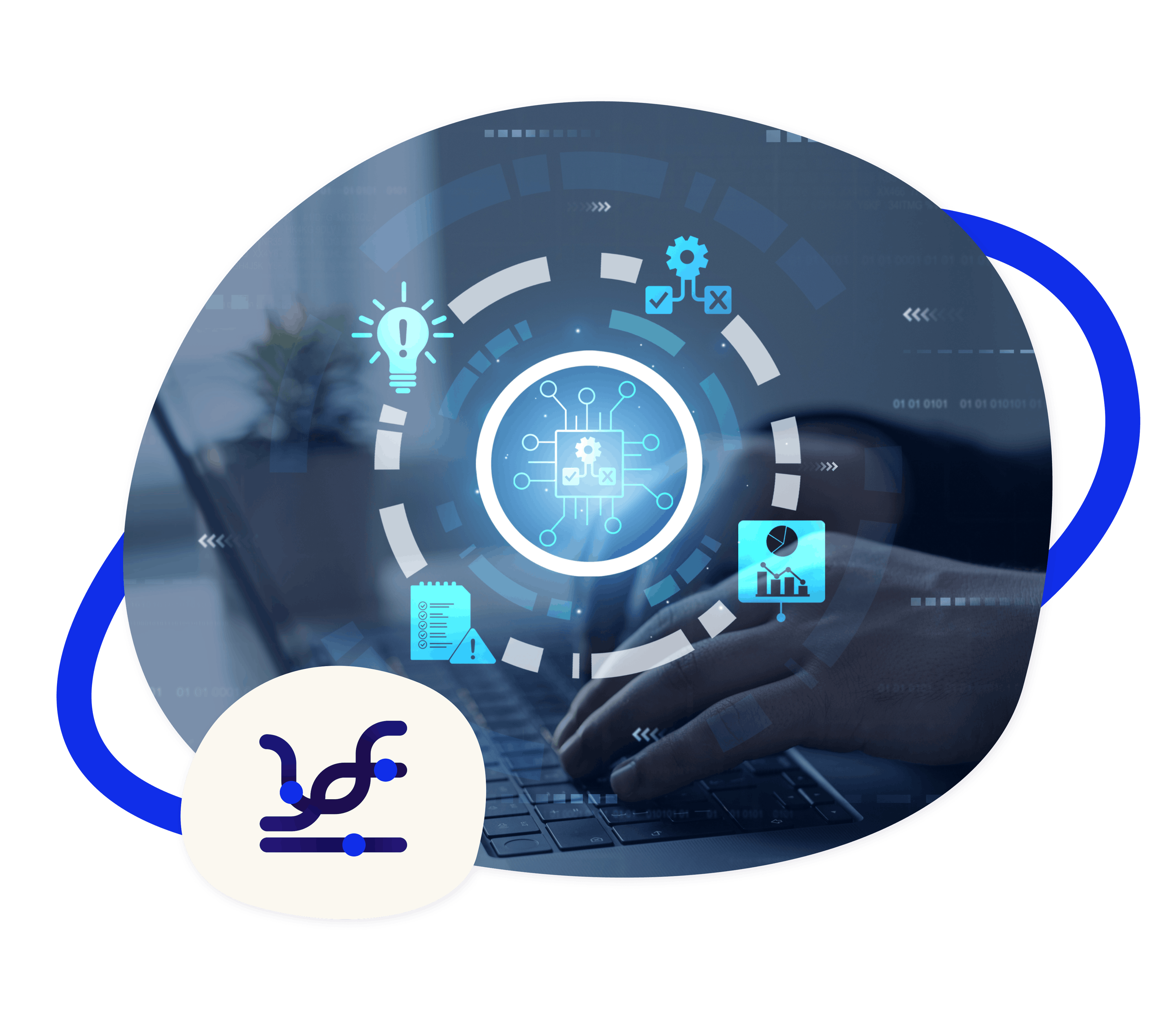
Chapter 4:
The ROI of Streamlined Mobility
For enterprise organizations, the value of global mobility is well understood. The challenge is not in proving its importance, but in demonstrating the level of return it can generate. However, quantifying the ROI of these initiatives can be complex, as the value is often realized in both tangible and intangible ways. In this section, we’ll look at the different ways enterprises measure the ROI of mobility – and what results they are seeing.

Cost Savings and Efficiency Gains
In our 2025 survey data we asked our respondents to estimate the financial benefit to their company of hiring an international employee. That includes factors such as increased revenue, reduced turnover, improved productivity, and so on.
While the value to the company of senior roles is greater than those of more junior roles, it's interesting to note that when factored against the reported cost of relocating an employee, senior roles report a lower ROI than more junior roles - though at 56% in the first year, the ROI of even the most senior employee is still considerable.
Our data also shows that larger organizations are generally reporting greater ROI than smaller organisations from relocating employees, though for the most senior roles this reverses. This indicates that global mobility is a great investment for larger organisations, though there is work to be done in order to maximise the value of more senior relocations.
Finally, when you compare average relocation costs reported in 2025 and those in 2023, costs have actually decreased by $3,000. Given then higher costs of relocating senior employees, that decrease could reflect a rise in global mobility at lower levels of an organization – but a few of our experts also reported that they are tailoring their relocation programmes to tailor them to different employees.
Key Benefits of Global Mobility
While cost efficiency is a critical metric, organizations also gain several strategic advantages from streamlined global mobility programs:
The data shows that larger organizations, both in terms of headcount and revenue, are more likely to report these benefits - plainly, enterprises are delivering global mobility to a high standard.
Interestingly, compared to our data from 2023, more people are reporting benefits to international mobility. This might reflect maturing attitudes to global mobility, or more mature programs delivering greater benefits.
Organizations also reported that employees using global mobility services were more likely to perform better, engage with company culture, and feel satisfied with their jobs. Again, larger organizations were more likely to agree with these statements, implying that global mobility can work better at the enterprise level than in smaller organizations.
Our data also shows that larger companies are more likely to sponsor more visas per year for employees. Comparing that data from 2023 and 2025, however, gives us a more nuanced picture. Companies reporting larger revenues are sponsoring larger numbers of visas in 2025 than they were in 2023, but companies with over 2,500 employees have actually reduced the number of visas they ares ponsoring. This suggests that cost remains a large factor in relocations - meaning that efficiency is vital for success in Global Mobility.


Tosin Adenrele, IQVIA
“We use a core-flex model. The core policy covers compliance-driven elements—work permits, tax obligations, and social security contributions. The flexible part allows business units to decide on additional support, like relocation allowances or family benefits. This structure provides consistency while allowing for regional and business-specific adaptations. It also helps manage costs— the businesses only pays for the additional support it chooses to offer.”

Soren Sturup-Toft, Immigration & Global Mobility Leader
“Someone moving from Germany to the Netherlands shouldn’t be getting the same relocation package as someone moving from Singapore to San Francisco. A more tailored approach is needed. Now, I like to use a tiered structure that accounts for differences in location, family size, and seniority within the business. This system makes things fairer and more personalized.”

Looking for ROI Numbers?
Use our ROI calculator to estimate how much time and budget you can save with Localyze, or benchmark against how others handle Global Mobility.
Conclusion: Turning Strategy into Scalable Impact
Despite the many challenges explored in this report —from navigating compliance across jurisdictions to balancing employee expectations with business needs— enterprise global mobility teams are uniquely positioned to drive strategic value. As our data and interviews show, global mobility is no longer simply about relocating employees. It’s about delivering meaningful, scalable impact for global organizations.

Throughout this report, we've seen how leading enterprises are responding to today's mobility landscape:
- By managing risk and compliance through a mix of internal expertise and expernal support.
- By scaling their operations using hybrid models that blend outsourcing, in-house oversight, and technology.
- By investing in systems and processes that create operational efficiencies while delivering excellent employee experiences.
- And by redefining ROI—going beyond cost savings to focus on agility, talent access, and long-term retention.
At the heart of successful mobility programs is alignment: between HR, business leaders, legal, and finance. The most effective global mobility teams are embedded into broader strategic planning processes, not treated as an afterthought or standalone function.
As global dynamics continue to shift—with the rise of AI, new migration policies, and changing workforce expectations—mobility’s importance will only grow. Organizations that want to stay competitive must continue to evolve, adopting scalable and human-centric approaches to meet these challenges head-on.
The opportunity is clear. With the right strategy, technology, and collaboration, global mobility can be a true differentiator for enterprise organizations—unlocking the talent, flexibility, and resilience they need to thrive in an uncertain world.
